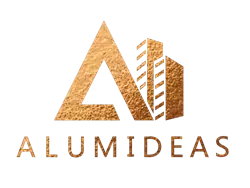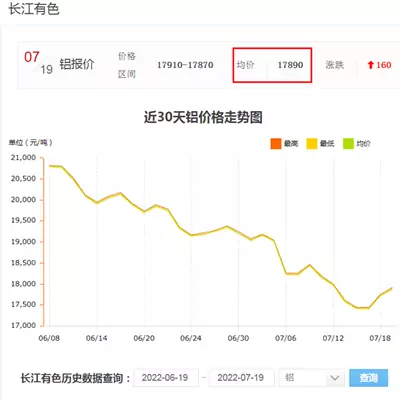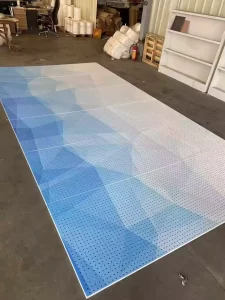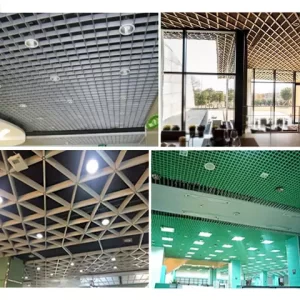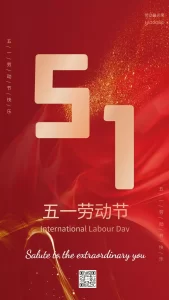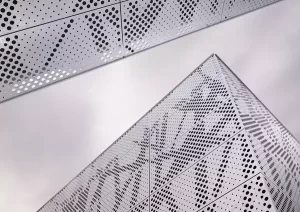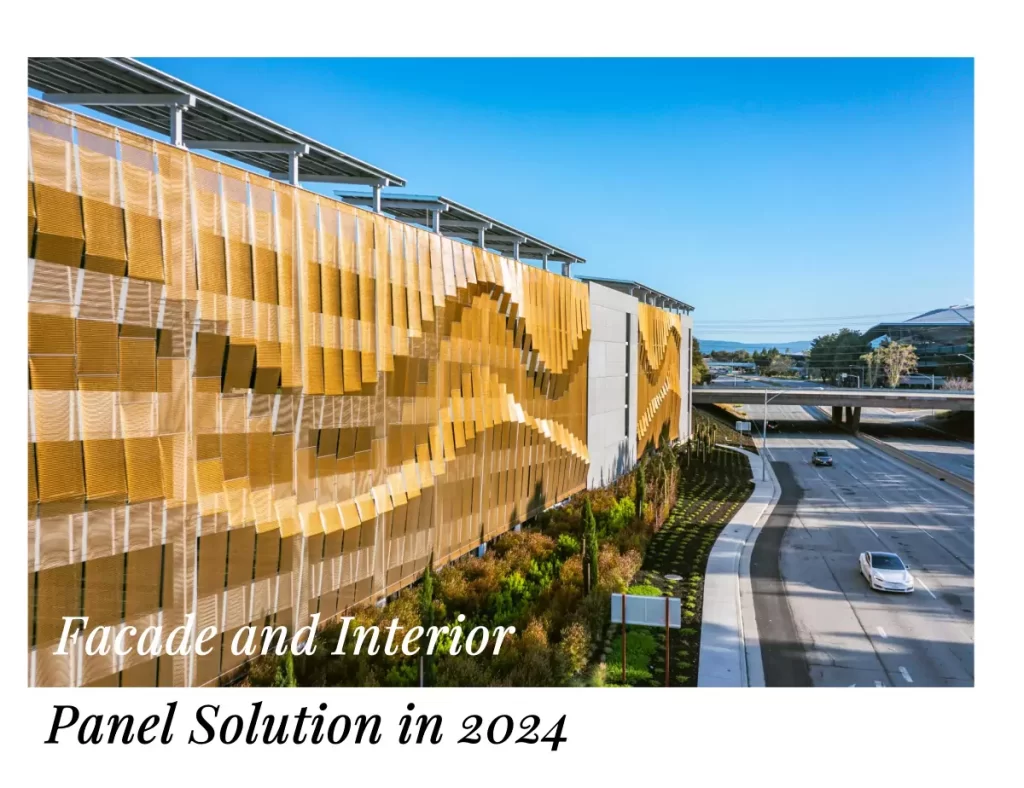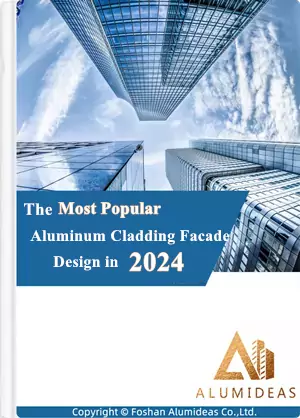pengenalan:
Dalam panduan komprehensif ini, we take an in-depth look at everything related to sistem pelapisan aluminium. We examine the manufacturing process, the different types of aluminum cladding, the benefits and considerations, installation and maintenance, cost factors, leading brands, dan banyak lagi.
If you’re an architect delving into the myriad of cladding possibilities or perhaps a property owner pondering over giving your place a fresh exterior face, this manual unravels. It’s peppered with nuggets of wisdom, ensuring you navigate the intricate world of aluminum cladding with clarity and confidence.
Untuk memastikan anda boleh mencari maklumat yang anda perlukan dengan cepat, kami telah menyediakan direktori kandungan. Apabila anda mengklik padanya, anda akan dibawa ke bahagian yang sepadan.
Isi kandungan
What is Aluminum Cladding?
Aluminum sheathing, composed of slender sheets of this metal, envelops a structure’s facade. Yet, when we talk about buildings and their protective layers, we’re essentially discussing how these thin plates become an integral part of an edifice’s outer persona.
The aluminum sheets used for cladding are produced from aluminum alloy plates. The alloying elements like manganese, magnesium, and zinc are added to pure aluminum to give it greater strength and durability. The alloyed aluminum is rolled into thin sheets that can be cut and bent into the desired cladding shapes.
Unlike load-bearing walls, aluminum cladding is not a structural element. Its purpose is to create an outer shell that shields the building from the weather and also defines architectural aesthetics. It serves as a second skin that wraps around a building’s structural core.
Aluminum cladding is very different from other forms of cladding like brick, wood, stucco, and vinyl. Key differences include:
- Aluminum cladding is much lighter than most other cladding options. This makes it easier to transport and install.
- It is very durable and corrosion-resistant compared to wood and stucco cladding.
- Aluminum spreads less fire compared to vinyl cladding.
- It provides better insulation than brick or concrete cladding.
Aluminum cladding comes in a wider range of cgreater finishes versus materials like concrete.
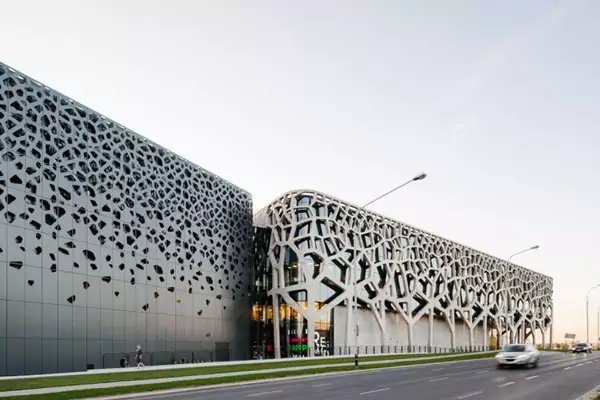
Sistem pelapisan aluminium digunakan pada dinding luar gim
The Manufacturing Process
Producing high quality aluminum cladding requires advanced manufacturing techniques and processes. Here are the key steps:
- Aluminum Coil Production – Cladding sheets begin as large aluminum coils. Alloys like 5000 dan 6000 series are commonly used for architecture. The coils are rolled to the desired thickness, typically between 0.7mm to 1.6mm.
- Cutting and Bending – Computer numerical control (CNC) machines cut the coil sheets into desired panel shapes and sizes. Bending and fabrication creates panels with folds, bevels, corrugations, or perforations.
- Rawatan permukaan – Finishing processes like powder coating or anodizing are used to apply color, texture and protect the aluminum from weathering and wear. Powder coating involves applying colored polymer powder to the metal and curing it in a furnace. Anodizing produces a durable oxide layer on the surface electrolytically.
- Laminating(ACP)- Composite panels are made by laminating aluminum to insulating polymer or mineral cores. This enhances rigidity and thermal performance.
- Quality Testing – Stringent testing ensures the aluminum cladding meets specifications for mechanical performance, coating adhesion, rintangan kakisan, and fire rating.
Advanced equipment for precision cutting, bending and fabrication along with expertise in finishing and quality control are vital for aluminum cladding production. The manufacturing processes shape the metal into durable, creatively shaped panels.
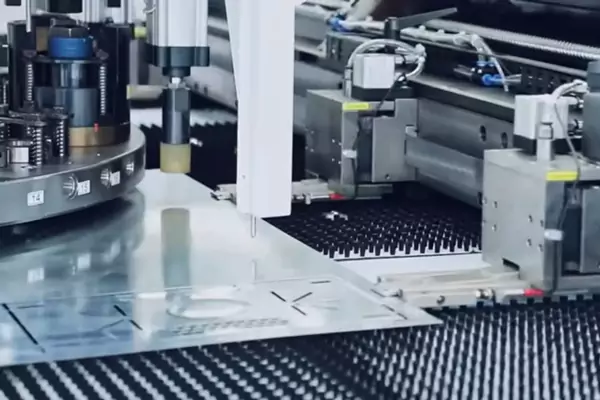
Proses pembuatan Alumideas - Turret punching
Types of Aluminum Cladding
Aluminum cladding offers versatility to meet different functional and aesthetic needs. Some of the major types include:
- Aluminum Cladding Panels – These consist of solid aluminum sheets cut into uniform rectangular or square panels. The flat panel design creates a sleek, seamless façade. Panel sizes vary but common dimensions are 30” x 10’ or 40” x 10’.
- Residential Aluminium Cladding – For houses or low-rise buildings, lightweight aluminum profiles are often used. These include corrugated sheets, planks, shingles, and vertical panels. Textured finishes provide visual interest.
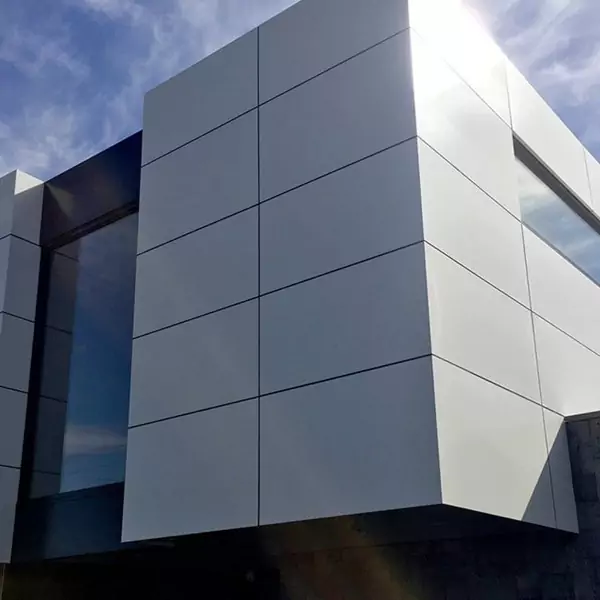
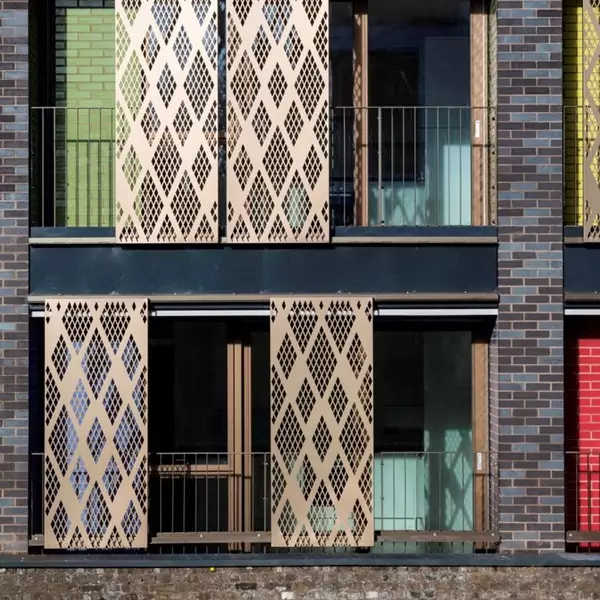
- Aluminium Wall Cladding – This is extensively used for exterior walls of commercial buildings and high-rises. Panels are available in different shapes, perforation patterns, and attachment systems. Horizontal or vertical orientation is possible.
- Aluminium Rainscreen Cladding – Rainscreen systems have a ventilated cavity between the exterior cladding and inner wall. This double-layer construction provides weather protection while allowing ventilation and drainage. Popular for high-rises.
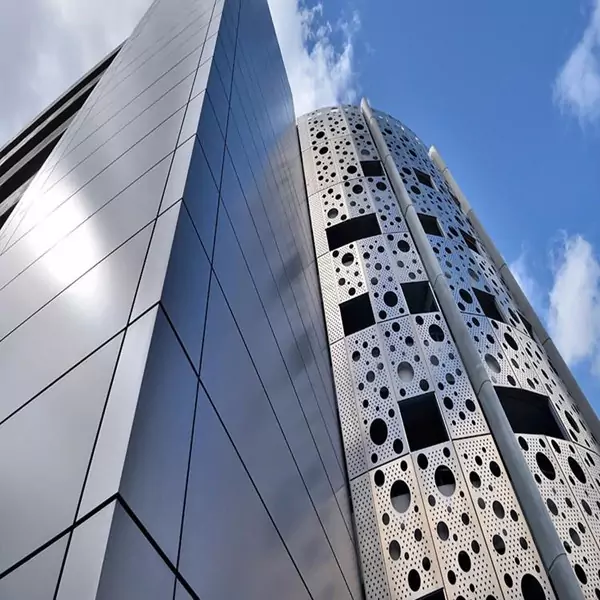
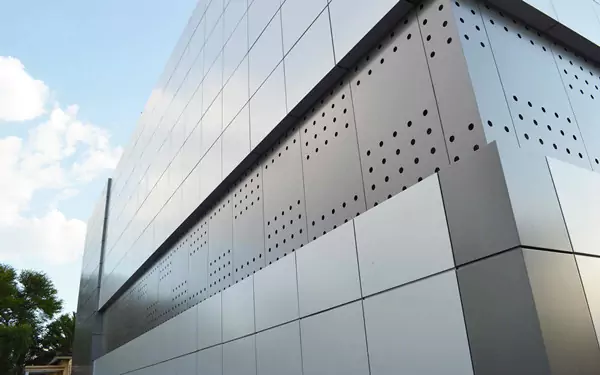
- Corrugated Aluminium Cladding – Formed into rippled, corrugated sheets, this adds dimension and visual appeal. The ridges make the sheets more rigid and improve drainage. Corrugated aluminum works well for interior cladding too.
- Vertical Aluminium Cladding – This refers to sleek linear panels oriented vertically. The narrow upright panels create a modern, cutting-edge look. Back lighting effects can be used for added drama.
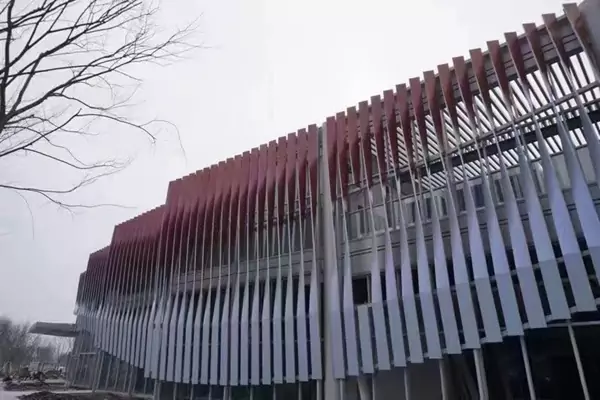
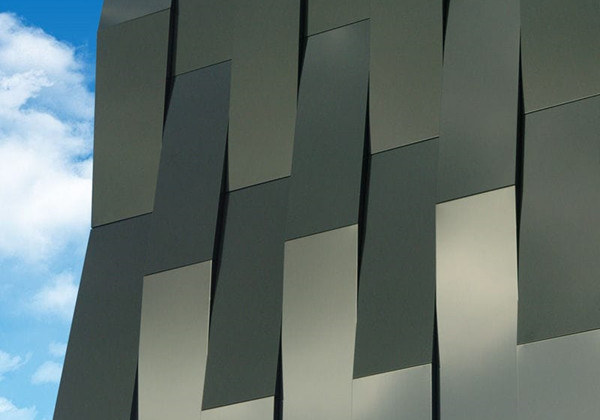
Benefits of Aluminum Cladding
Aluminum wall panels can be finished in a variety of ways to achieve different aesthetic effects. Whether you’re looking for a smooth, matte finish or a textured, glossy one, Alumideas can provide the perfect solution. We offer a range of finishes, including powder coating, anodizing, and PVDF coating, each offering unique benefits.
Architects and builders choose aluminum cladding for its many benefits:
- Ketahanan– Aluminum’s anti-corrosion properties give it an exceptionally long service life of 40-50 tahun. It maintains its appearance with minimal maintenance.
- Penyelenggaraan Rendah– Aluminum cladding only requires occasional cleaning. It does not need repainting or special upkeep over its lifetime.
- Penebat Terma– Aluminum itself conducts heat but when used with insulated cores, it provides very good insulation values. This improves energy efficiency in buildings.
- Acoustic Dampening– Insulated aluminum cladding helps absorb noise, an important feature in urban areas. The metal skin dampens external sounds.
- Aesthetic Versatility– With options like perforated, embossed, beralun, brushed, or metallic finishes, aluminum allows creative facade designs not possible with other cladding materials.
Pros and Cons of Aluminum Cladding
Pros of Aluminum Cladding:
- Extreme durability and weather resistance
- Requires very little maintenance over its long service life
- Lightweight compared to materials like natural stone or concrete
- Excellent thermal and sound insulation when used with cores
- Wide aesthetic options available to meet design visions
- 100% recyclable at end of life
Potential Cons to Consider:
- Higher initial cost than fiber cement or vinyl cladding
- Installation can be complicated, requires aluminum expertise
- Difficult to alter appearance after installation
- Risk of galvanic corrosion if combined with less noble metals
- Performance is highly dependent on quality of installation
Installation Process
- Cladding panels are mounted to a subframe, not directly affixed to the building wall.
- The subframe provides the support structure and is attached to the wall with brackets.
- Cladding panels interlock with mounting clips, rails, or hooks pre-installed on the subframe.
- Gaskets and sealants are used to weatherproof panel joints.
Key Installation Considerations
- Subframe must be designed to accommodate wind loads and seismic factors.
- Allowance must be made for thermal expansion and contraction of panels.
- Detailing at panel joints and connections is crucial for watertightness.
- Experienced installers should be used for complex shapes and alignments.
- Special equipment like mechanical lifts often needed for cladding on high-rises.
Maintenance and Care
Proper maintenance is key to ensuring aluminum cladding retains its appearance and performance over its long lifespan. Regular cleaning is recommended to prevent buildup of dirt or environmental deposits. Use a soft cloth, sponge or brush with warm water and a mild pH-neutral detergent. Avoid abrasive scouring powders or pads that could scratch the finish. For stubborn stains, specialized aluminum cleaners can be used sparingly. Always rinse off any cleaning agents thoroughly after washing the panels.
Beyond cleaning, building owners should periodically inspect the cladding for any damage, deterioration of seals and joints, or accumulation of moisture or debris in the cavity. Remedial work like re-applying sealant at joints helps prevent any serious failures or leaks. Testing the coating adhesion every 2-3 years identifies any potential concerns early. Overall, aluminum cladding requires very little maintenance compared to other building materials. But it is important not to neglect simple care for longevity.
Cost Implications
Aluminum cladding is generally more expensive than basic options like vinyl, fiber cement or wood. But it offers excellent value compared to high-end metals like zinc, copper or stainless steel. The initial investment is offset over the lifespan of aluminum due to its durability and virtually zero maintenance needs. Factors that impact overall cost include:
- Type of aluminum alloy More premium alloys cost more
- Coating method Anodizing more expensive than powder coating
- Design complexity Intricate shapes and perforations add cost
- Accessibility High-rise installation requires special equipment
- Transportation Costs increase for remote project locations
- Labor Complex designs require specialized installers
When planned appropriately, aluminum cladding can meet both aesthetic and budgetary goals for building exteriors.
Know more about aluminum cladding prices from this article: [Harga Kilang] A Secret In Aluminum Panel Industry
Suppliers and Brands
Aluminum cladding systems are produced by metal fabrication specialists and made available internationally through major suppliers. Well-known aluminum cladding brands include:
Alumideas – provides different solutions from many aspects, termasuk pemilihan bahan plat aluminium, pemilihan rawatan permukaan, reka bentuk tahan angin, reka bentuk pemasangan, fasad panel komposit aluminium, dan sebagainya.
Larson – offers wide range of panel textures like perforated, ribbed, or embossed along with colorful finishes
Reynobond – manufactures aluminum composite panels with polyethylene or fire-resistant mineral cores
Alucoil – supplies pre-finished aluminum coils for customized cladding production
VM Zinc – provides extensive decorative cassettes, louvers, and 3D panell
Reputable brands and experienced suppliers can recommend appropriate aluminum cladding solutions for specific building projects
Aluminum cladding provides an excellent balance of durability, estetika, performance and cost compared to many other exterior building skin materials. Aluminum is lighter weight and more rigid than vinyl siding. It offers better corrosion resistance than galvanized steel. Aluminum sheets can be fabricated into more expressive 3D forms versus fiber cement. And aluminum cladding provides better insulation and sound absorption than full glass curtain walls.
Some common alternative cladding options include:
Fiber Cement – Durable and fire resistant but limited aesthetics.
Metal Composite Materials – Lightweight but less rigid than aluminum.
Natural Stone – Beautiful but very heavy and fragile.
Brick – Traditional appearance but poor thermal insulation.
Glass – Alluring transparency but higher cost and poor acoustic insulation.
Each material has pros and cons. Aluminum stands out for its versatility and well-rounded performance.
Design and Aesthetic Considerations
Aluminum cladding offers immense design flexibility for building exteriors. It can be fabricated into virtually any shape and perforated in infinite patterns. Curving panels, folding facades, and complex 3D forms are all possible. The material also takes well to different textures and finishes like embossed, brushed, or mirror-finished. When lit from behind, aluminum cladding creates stunning visual effects.
Current trends include bold use of dark, reflective color palettes. Contrasting vertical and horizontal panel directions add dynamism. Combining aluminum with other materials like wood, concrete or stone creates modern blended facades. Emphasis is placed on striking perforation and back lighting for an ethereal, glowing look. Organic shapes and abstract textures are also popular directions for aluminum cladding.
Technical Aspects
Standard Sheet Sizes
- Ketebalan: 8mm to 4.0mm are common
- Lebar: 1000mm or 1500mm
- Panjang: Up to 5m panels possible
Calculating Required Cladding
- Measure total exterior wall area
- Add 5-10% extra for waste, overlaps, edges
- Account for design factors like joints, perforations
- Consider delivery constraints for large panels
Environmental Impact
- Aluminum is 100% recyclable without loss of properties
- Recycled content reduces energy use by over 90% versus virgin aluminum
- Powder coating containment prevents atmospheric emissions
Specifiers should maximize recycled content and recyclability to improve sustainability.
Case Studies
The Shard, London – Features anodized aluminum cladding with fractal shapes and angles reflecting light. This striking facade defines the London skyline.
Absolute Towers, Canada – Rippling aluminum balconies with a wave-like pattern give these residential towers a sculptural look.
One Central Park, Sydney – Prefabricated aluminum panels with organic flower-like patterns integrate this building with surrounding greenery.
Kesimpulan
Aluminum cladding gives architects and builders an invaluable exterior skin option combining aesthetics, prestasi, and longevity. With environmental benefits like recyclability and energy savings from insulation, aluminum cladding is also a sustainable facade choice. Advancements in manufacturing allow for previously impossible shapes, tekstur, and effects. With informed design assisted by experienced metal cladding professionals, aluminum enables stunning yet pragmatic building envelopes.
Soalan Lazim
Apakah tujuan pelapisan aluminium?
Aluminum cladding protects the building from weather while providing a durable, low-maintenance and aesthetically appealing facade. It improves insulation while allowing design freedom.
How long does aluminum cladding last?
With minimal maintenance, aluminum cladding lasts over 40-50 years in most environments due to its anti-corrosion properties.
What is the difference between facade and cladding?
The facade refers to the entire exterior of the building. Cladding is the external skin or envelope covering the facade.
What are the major considerations when designing cladding?
Wind loads, vibration resistance, thermal expansion, joint detailing, moisture management, accessibility for installation/maintenance.
Alumideas is a aluminum cladding manufacturer in China. Kami menyediakan penyelesaian sehenti untuk projek pelapisan hiasan dalaman dan luaran anda. Minta sebut harga sekarang!
Kami akan menghubungi anda dalam 1 hari bekerja, sila beri perhatian kepada e-mel dengan akhiran “@alumideas.com”.
